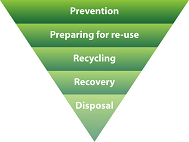Duty of Care/Waste Transfer Note
Are you affected?
Any business that produces, handles or disposes of controlled waste has a statutory obligation to ensure it is managed correctly under Duty of Care legislation.
Duty of Care requirements are described on the GOV.UK website.
If you produce waste, but are not responsible for its disposal eg an office block where there are communal bins in the basement managed by a facilities management company, then the point of Duty of Care in relation to containment and transfer notes sits with the facilities management company. However, as the waste producer, you are still responsible for making sure the waste is being correctly handled. The EA suggest that best practice in this scenarions would be for producers:
- To have copies of the waste transfer note related to their waste
- To ensure that their lease Agreement clearly states that the landlord takes responsibility for the waste.
‘Controlled waste’ is effectively all waste that arises from business premises. This includes waste that is collected for recycling as well as waste that is disposed of to landfill or incineration.
What is required?
- Waste is stored correctly ie it must be properly contained
- It is only collected by registered waste carriers (unless being moved by the waste producer’s own vehicles)
- All collections are covered by a valid document – a waste transfer document for non-hazardous waste and a consignment note for hazardous waste – that includes a written description of the waste to enable anyone handling it to do so safely and appropriately
- Records of transfers of waste are kept for at least two years (non-hazardous) or 3 years (hazardous)
- Waste is only taken to an authorised facility that has the necessary waste management licensing – ignorance of the disposal site is no defence if your waste is found flytipped.
EPA 1990 S.34 (2) states ‘The duty imposed by subsection (1) above does not apply to an occupier of domestic property as respects the household waste produced on the property.’ However, the responsibility to only allow waste to be removed by an authorised waste carrier still applies under subsection 2A.
Defra revised the Code of Practice in March 2016 to a much small document. The previous Code of Practice is no longer therefore in force but gives a more comnplete explanation of some issues which are not clearly explained in the new diocument.
Scotland has published a Duty of Care Code of Practice which clearly states the expectations for separate collections of recyclables and is a much more comprehensive document that the England and Wales CoP.
The NIEA has revised Guidance introduced in 2012, also much more comprehensive.
360 Environmental has produced a Duty of Care Flowchart that you may find useful.
Waste Transfer notes
Every transfer of waste must be covered by the appropriate documentation. For non-hazardous waste, waste transfer documentation is required where there is a transfer between two parties – this is generally a Waste Transfer Note (WTN). For hazardous waste, there must be a Consignment Note in place for any movement between two locations.
Waste transfer documents are a legal requirements that must contain certain information including a signature from both parties between whom the waste is being transferred. From 28th September 2011, a transfer note must conform with the new requirements laid down by the Waste (England and Wales) Regulations 2011. The EA provides a downloadable template, but this does not have to be used. Any form can be used so long as it contains the relevant legal information.
The Waste Regulations (England and Wales) 2014 permits the use of alternative documentation to the Waste Transfer Note such as invoices or even email. But the legal requirements for what must be included remain the same.
It must include the following:
- A brief written description of the waste being transferred.
- The correct EWC code for the waste.
- An indication of how the waste is contained. Eg. is it loose, in a sack, skip or drum?
- A SIC 2007 code .
- A tick box to state that the waste hierarchy has been considered with the relevant words (see below)
- Identify the amount of waste being passed on, for example the number of sacks or other containers, the volume of waste or its weight.
- List your name and identify that you are the producer of the waste.
- List the name of the person you are passing the waste to and their status, for example a registered waste carrier, including their registration number.
- Give the address where you passed the waste to the other person as well as the date and time that you gave him the waste.
- Be signed by both parties and be kept for at least two years.
For repeated transfers, where the description of the waste and all the circumstances remain the same – carrier, transferror, location of transfer – a ‘season ticket’ can be used to cover all transfers i.e. one note which can last up to 12 months.
The WTN requires a waste hierarchy statement with the following words recommended by Defra guidance:
By signing in Section D below I confirm that I have fulfilled my duty to apply the waste hierarchy as required by Regulation 12 of the Waste (England and Wales) Regulations 2011
It is illegal to collect – or have collected – commercial or industrial non-hazardous waste without valid waste transfer documentation in place. Normally, the waste collection company would generate the transfer note, but it is the transferror’s legal responsibility to ensure that the EWC code is correct.
Waste carriers do not need to carry a copy of the waste transfer documentation on their vehicle but if stopped by the police, environmental Agency or local authority, must produce a copy within 7 days under the Controlled Waste Regulations.
The WTN should include both a brief written description and a European Waste Catalogue (EWC) code, often known as the List of Wastes (LOW) code. This description and code are extremely important:
- They ensure that the person to whom the waste is being transferred understands the handling requirements.
- The EWC code determines whether a site can receive the waste as all sites operating under an Environmental Permit or an Exemption are restricted to certain EWC codes.
Please see the EWC section for a full explanation of how the codes should be used.
To identify the correct EWC code, please visit our Wastesupport website for a specialised search facility.
This requirement applies to the transferror who must therefore now ensure that they dispose of their waste as high up the hierarchy as possible. This prioritises prevention first and landfill disposal last. In practice, the expectation is that a business should at least be recycling where possible.

Further information can be found on the EA website. Guidance has been issued by Defra and there is also a WRAP Online tool giving a more detailed process on how it could be applied.
Electronic Duty of Care (edoc)
The EA launched a new paperless Waste Transfer Note system called edoc at the end of January 2014. This allows parties to the WTN to complete and record them online saving time and useless bits of paper.
The system has been set up on a completely different website to GOV.UK meaning that it is not subject to the whims of a geek as to whether it remains available or not.
